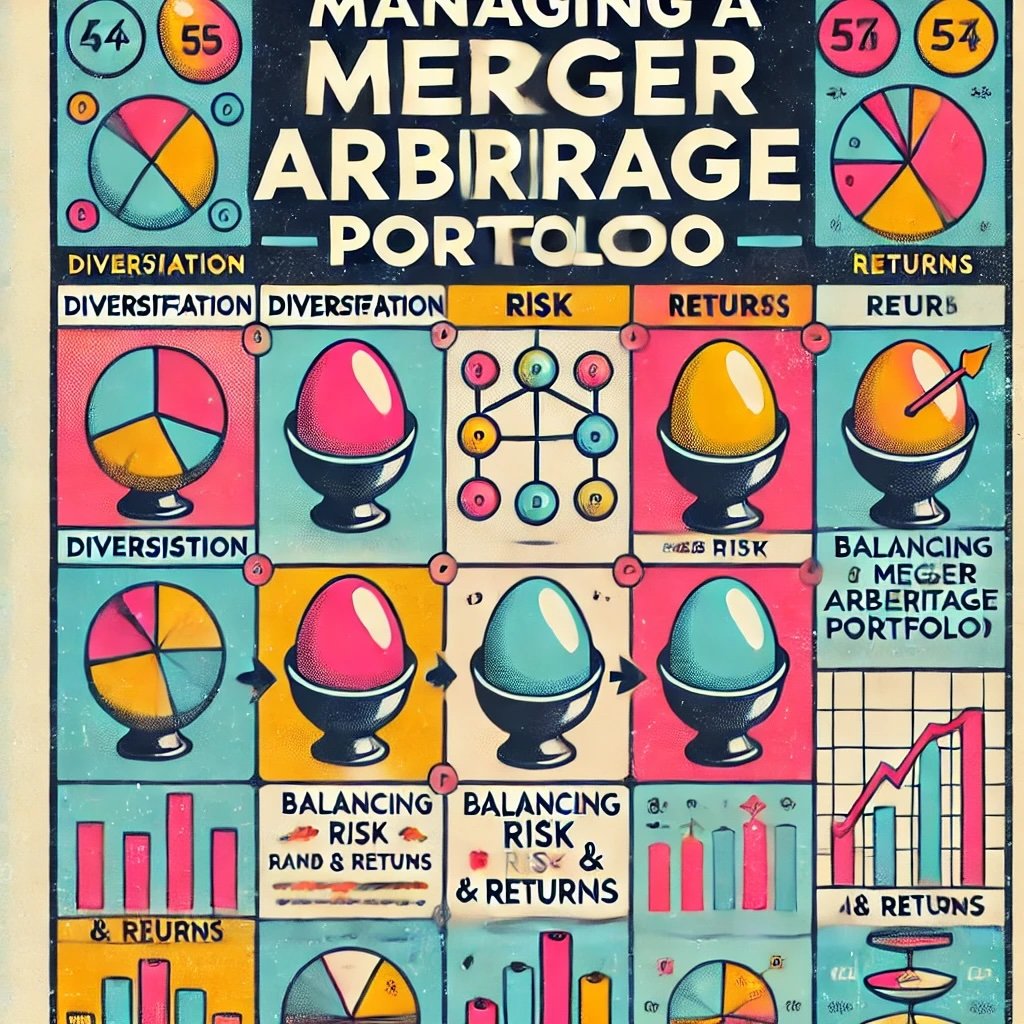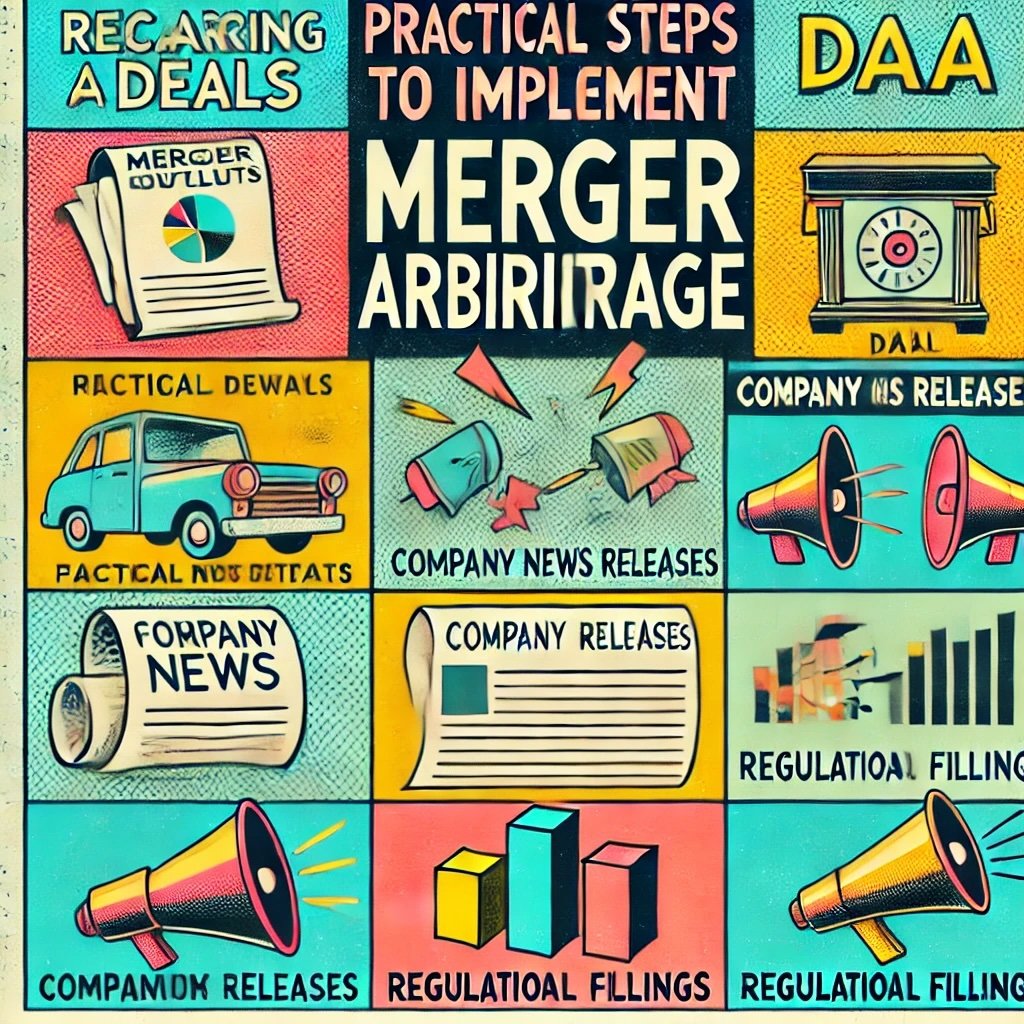When it comes to hedge fund legends, John Paulson is a name that resonates powerfully in the investment world. He’s the financial maestro who famously predicted the subprime mortgage crisis, turning a $15 billion profit for his fund in 2007. But Paulson’s success isn’t a one-hit wonder. He has consistently leveraged sophisticated strategies to stay ahead of the market, with merger arbitrage being one of his secret weapons.
source: David Rubenstein on YouTube
Who Is John Paulson?
So, what’s in it for you? The purpose here is to demystify Paulson’s merger arbitrage strategy and explore how you, as an investor, can apply it. We’re breaking down complex financial concepts into digestible insights, aiming to equip you with tools that could enhance your investment approach. Whether you’re a seasoned trader or just starting out, understanding merger arbitrage can add a new dimension to your portfolio.

What Is Merger Arbitrage?
Before we dive into the nitty-gritty, let’s get on the same page about merger arbitrage. At its core, merger arbitrage is an investment strategy that seeks to profit from the price discrepancies that occur before and after a merger or acquisition announcement.
Key Aspects of Merger Arbitrage:
- Price Gaps: When a merger is announced, the target company’s stock price often jumps but doesn’t immediately reach the acquisition price, creating a spread.
- Risk and Reward: The spread exists due to uncertainties—regulatory approvals, shareholder votes, or financing issues—that could derail the deal.
- Profit Potential: By assessing these risks, investors can decide if the potential reward justifies the investment.

The Role in Event-Driven Investing
Merger arbitrage is a subset of event-driven investing, which focuses on exploiting inefficiencies that occur during corporate events like mergers, acquisitions, bankruptcies, or restructurings. These events can cause significant shifts in a company’s stock price, independent of broader market movements.
Why Focus on Event-Driven Strategies?
- Diversification: Adds a non-correlated asset class to your portfolio.
- Opportunity: Capitalizes on market inefficiencies that others might overlook.
- Risk Management: Allows for strategies that hedge against general market volatility.
Tip for Best Practices: Always stay informed about market news and corporate announcements. Timely information is crucial for successful event-driven investing.

Understanding Merger Arbitrage
What Is Merger Arbitrage?
Ever wondered how some investors make money off mergers and acquisitions before the ink is even dry? That’s where merger arbitrage comes into play. At its core, merger arbitrage is an investment strategy that aims to profit from the price discrepancies that occur after a merger or acquisition is announced but before it’s completed.
Here’s the deal: when a company announces it will acquire another, the target company’s stock price typically jumps—but not all the way up to the proposed acquisition price. This gap exists because of the uncertainty surrounding the deal’s completion. Merger arbitrageurs step in to exploit this gap, betting that the deal will go through and they can pocket the difference.
How It Works:
- Announcement: Company A announces plans to acquire Company B at a premium.
- Price Gap: Company B’s stock price rises but stays below the offer price.
- Investment: An arbitrageur buys shares of Company B, aiming to profit when the stock price aligns with the acquisition price upon deal completion.
Tip for Best Practices: Always scrutinize the terms of the deal and assess the likelihood of its completion before jumping in.

Types of Deals
Not all mergers and acquisitions are created equal. Understanding the type of deal is crucial because it affects how you might structure your arbitrage strategy.
1. Cash Mergers
In a cash merger, the acquiring company offers cash for the target company’s shares.
- Example: Company A agrees to buy Company B for $50 per share in cash.
- Arbitrage Opportunity: If Company B’s stock is trading at $48, buying now could yield a $2 profit per share when the deal closes.
2. Stock-for-Stock Mergers
Here, the acquiring company offers its own stock in exchange for the target company’s shares.
- Exchange Ratio: The deal specifies how many shares of the acquirer you’ll receive for each share of the target.
- Example: Company A offers 1.5 of its shares for each share of Company B.
- Arbitrage Consideration: You’ll need to consider the potential fluctuations in Company A’s stock price.
3. Mixed Deals
These deals involve a combination of cash and stock.
- Example: Company A offers $30 in cash plus 0.5 shares of its stock for each share of Company B.
- Complexity: Mixed deals add layers of complexity due to the need to assess both cash and stock components.
Tip for Best Practices: Pay close attention to the deal’s structure to understand the risks and potential rewards fully.
Risk and Reward
While merger arbitrage can be lucrative, it’s not without risks. The primary risk is that the deal might fall through, causing the target company’s stock price to plummet.
Potential Gains
- Predictable Returns: If the deal closes as planned, the returns are relatively predictable.
- Short Time Frame: Deals often close within months, allowing for quicker realization of profits.
Potential Risks
- Deal Break Risk: Regulatory hurdles, financing issues, or shareholder opposition can derail a deal.
- Market Risk: Broader market movements can affect stock prices, especially in stock-for-stock deals.
- Opportunity Cost: Capital tied up in a failed deal can’t be used elsewhere.
Managing Risks
- Due Diligence: Thoroughly research the likelihood of deal completion.
- Diversification: Spread investments across multiple merger deals to mitigate individual deal risk.
- Hedging: Use options or short positions to hedge against adverse movements.
Tip for Best Practices: Never invest more than you’re willing to lose in a single deal. Always have an exit strategy in case things go south.

Identifying Merger Arbitrage Opportunities
So, you’re intrigued by merger arbitrage and ready to dive in. But how do you spot these opportunities in the wild? Let’s break it down.
Key Indicators to Watch
Identifying potential merger arbitrage opportunities involves keeping an eye on several critical signals. Here’s what you should look for:
1. Announced Mergers
The most straightforward opportunities arise when companies publicly announce a merger or acquisition.
- Press Releases: Official statements from the companies involved.
- Financial News Outlets: Reports from credible sources like Bloomberg or The Wall Street Journal.
- Regulatory Filings: Documents filed with the SEC, such as Form 8-K.
Tip for Best Practices: Set up news alerts for sectors or companies you’re interested in to catch announcements in real-time.
2. Pending Regulatory Approvals
Even after a deal is announced, it often requires the green light from regulatory bodies.
- Antitrust Reviews: Agencies like the FTC or the European Commission may need to approve.
- Industry-Specific Regulators: For example, the FDA in pharmaceutical deals.
- International Approvals: Deals involving companies in multiple countries may need approval from each jurisdiction.
3. Shareholder Votes
Both companies’ shareholders may need to approve the deal.
- Proxy Statements: Look for details about shareholder meetings and voting procedures.
- Major Shareholder Opinions: Institutional investors can sway the vote.
Tip for Best Practices: Monitor investor sentiment by following shareholder forums and financial analysts.

Analyzing Deal Terms
Understanding the nuts and bolts of the merger agreement is crucial. Here’s what to focus on:
Type of Deal
- Cash Deal: Know the exact cash amount per share being offered.
- Stock-for-Stock Deal: Understand the exchange ratio and how it might be affected by stock price fluctuations.
- Mixed Deal: Analyze both the cash and stock components.
Timeline
- Expected Closing Date: Gives you an idea of how long your capital will be tied up.
- Milestones: Regulatory approval dates, shareholder meeting dates, etc.
Contingencies
- Financing Conditions: Is the acquirer relying on debt that hasn’t been secured yet?
- Material Adverse Change Clauses: Conditions under which the acquirer can back out.
- Regulatory Hurdles: Any known issues that might complicate approvals.
Tip for Best Practices: Read the merger agreement carefully—it’s often filed as an exhibit in SEC filings.
Case Study: Paulson’s Bet on the Pfizer-Allergan Merger
Let’s look at how John Paulson leveraged these indicators in a real-world scenario.
The Opportunity
In 2015, Pfizer announced a $160 billion merger with Allergan, aiming to create the world’s largest pharmaceutical company.
- Type of Deal: Stock-for-stock merger.
- Strategic Move: Pfizer aimed for a tax inversion to reduce its tax burden.
Paulson’s Analysis
- Regulatory Scrutiny: Recognized that tax inversion deals were under political pressure.
- Deal Terms: Noted the exchange ratio and potential benefits.
- Risk Assessment: Weighed the likelihood of the U.S. Treasury blocking the deal.
The Outcome
- Deal Break: In April 2016, the U.S. Treasury introduced new rules making tax inversions less attractive, leading Pfizer to abandon the merger.
- Paulson’s Move: Anticipating the risks, Paulson had adjusted his position accordingly, minimizing losses.
Lesson Learned: Even seasoned investors like Paulson can face deal breaks. The key is thorough analysis and risk management.

Evaluating Deal Risk
Before diving into a merger arbitrage opportunity, it’s essential to thoroughly assess the risks involved. Not every announced deal reaches the finish line, and understanding potential pitfalls can safeguard your investments. Let’s explore the key areas where risks may arise and how to evaluate them effectively.
Regulatory Risk
Regulatory approval is often the tallest hurdle a merger must clear. Government agencies have the authority to block deals that they believe could harm competition, national security, or public interest. Failing to obtain regulatory consent can lead to a deal’s collapse, resulting in significant financial losses for investors banking on its completion.
Assessing Antitrust Concerns
Antitrust laws are designed to prevent the creation of monopolies and promote fair competition. When two industry giants plan to merge, regulators scrutinize the potential impact on the market.
- Market Share Analysis: Examine whether the combined entity would control a disproportionate share of the market. For instance, if a merger would result in a single company owning 70% of the market, regulators might see this as a threat to competition.
- Competitive Landscape: Assess the number of remaining competitors and the ease with which new entrants could join the market. A merger in a market with high barriers to entry is more likely to face regulatory pushback.
- Past Regulatory Decisions: Look into previous rulings on similar mergers within the industry. Historical precedents can offer valuable insights into how regulators might view the current deal.
Tip for Best Practices: Regularly monitor updates from regulatory bodies such as the Federal Trade Commission (FTC) or the European Commission. Early indications of concern can help you adjust your position accordingly.
Political and National Security Considerations
Sometimes, mergers face challenges not just from competition regulators but also from governmental concerns about national security or economic policy.
- Foreign Investments: Deals involving foreign companies acquiring domestic firms, especially in sensitive industries like technology or defense, may face additional scrutiny.
- Political Climate: Changes in government policies or leadership can influence the likelihood of approval. For example, a government prioritizing domestic jobs might oppose mergers that could lead to layoffs.
Real-World Example: The attempted acquisition of Qualcomm by Broadcom was blocked by the U.S. government over national security concerns, despite both companies being industry leaders in semiconductors.

Financing Risk
Even if a merger makes strategic sense and gains regulatory approval, it can still falter if the acquiring company lacks the necessary funds. Financing risk revolves around the acquirer’s ability to secure the capital required to complete the transaction.
Evaluating the Acquirer’s Financial Health
- Balance Sheet Strength: Analyze the acquirer’s assets and liabilities. A company with a robust cash reserve and manageable debt is better positioned to finance a deal.
- Cash Flow Statements: Consistent positive cash flow indicates that the company generates enough revenue to support additional debt or finance a cash deal outright.
- Credit Ratings: Review ratings from agencies like Moody’s or Standard & Poor’s. A lower credit rating can increase borrowing costs or limit access to capital markets.
Understanding Financing Methods
- Cash Deals: Require the acquirer to have sufficient liquid assets or the ability to raise funds quickly. This might involve issuing bonds or taking out loans.
- Stock Deals: Involve exchanging shares, which can dilute existing shareholders’ equity. The acquirer’s stock price volatility can impact the deal’s attractiveness.
- Mixed Deals: Combine cash and stock, adding complexity to the financing structure.
Tip for Best Practices: Read the acquirer’s recent financial reports and investor presentations. They often provide insights into how the company plans to finance the merger and any potential hurdles they foresee.
Market Sentiment
Market perceptions, investor confidence, and even rumors can significantly impact the arbitrage spread—the difference between the target company’s current stock price and the offer price. Understanding market sentiment helps in anticipating price movements that could affect your returns.
Gauging Investor Confidence
- Stock Price Fluctuations: Sudden drops or spikes in the acquirer’s or target’s stock prices may indicate changing investor sentiment about the deal’s viability.
- Trading Volume: Unusually high trading volumes can signal that institutional investors are making significant moves, either supporting or doubting the deal.
- Analyst Reports: Financial analysts often publish their expectations and concerns regarding high-profile mergers. Their opinions can sway public sentiment.
Impact of Media and Rumors
- News Articles: Positive or negative press can influence how the market perceives the merger. Sensational headlines might exaggerate risks or benefits.
- Social Media: Platforms like Twitter and Reddit can amplify rumors. While not always reliable, they can impact short-term trading behavior.
Tip for Best Practices: Maintain a balanced perspective. Verify information through credible sources before making investment decisions based on market chatter.

Managing a Merger Arbitrage Portfolio
So, you’ve identified some promising merger arbitrage opportunities. Great! But how do you manage your portfolio to maximize returns while minimizing risks? Let’s dive into the essentials of portfolio management in the world of merger arbitrage.
Diversification: Don’t Put All Your Eggs in One Basket
In merger arbitrage, diversification isn’t just a buzzword—it’s a survival strategy. Investing all your capital in a single deal is like betting your entire hand on one card. If the deal falls through, you could face significant losses.
Why Diversify?
- Mitigate Individual Deal Risk: Each merger comes with its own set of risks—regulatory hurdles, financing issues, shareholder dissent. Diversifying spreads out this risk.
- Smooth Out Returns: Successful deals can offset the losses from deals that fail, leading to more consistent portfolio performance.
- Capture More Opportunities: By investing in multiple deals, you increase your chances of being part of highly profitable mergers.
Tip for Best Practices: Aim to have a mix of deals across different industries and regions. This not only diversifies deal-specific risk but also shields you from sector-specific downturns.
How to Diversify Effectively
- Number of Positions: While there’s no magic number, holding positions in at least 10-15 different deals can provide a good balance.
- Varying Deal Sizes: Include both large-cap and small-cap mergers to capture different risk-reward profiles.
- Different Stages: Invest in deals at various stages—some nearing completion, others just announced.
Position Sizing: Balancing Risk and Reward
Determining how much capital to allocate to each position is a critical decision. Too much in one deal can be risky; too little in another might dilute potential gains.
Factors to Consider
- Deal Risk Assessment: Higher-risk deals should generally have smaller position sizes.
- Potential Return: If a deal offers a higher arbitrage spread (the difference between the current price and the deal price), you might allocate more—but only if the risk is acceptable.
- Correlation Between Deals: If two deals are in the same industry or affected by similar risks, consider reducing the combined exposure.
Tip for Best Practices: Use a position sizing model, like the Kelly Criterion or risk parity, to make systematic allocation decisions based on risk and expected return.
Practical Steps
- Set a Maximum Position Limit: Decide on a maximum percentage of your total portfolio for any single position—say, no more than 10%.
- Adjust for Confidence Level: If you’re highly confident in a deal’s success, you might allocate slightly more, but stay within your risk parameters.
- Regularly Rebalance: Market conditions and deal progress can change. Reassess and adjust your positions accordingly.
Hedging Strategies: Protecting Your Downside
Even with diversification and careful position sizing, unforeseen events can impact your portfolio. That’s where hedging comes into play.
Why Hedge?
- Mitigate Market Risk: Protect against broad market movements that could affect your positions.
- Deal-Specific Risks: Hedge against specific uncertainties in a merger, such as regulatory decisions or financing issues.
- Volatility Management: Reduce the impact of price swings on your portfolio’s value.
Tip for Best Practices: Hedging isn’t about eliminating risk entirely—it’s about managing it to acceptable levels.
Common Hedging Techniques
- Options Contracts: Purchase put options on the target company’s stock to protect against downside risk if the deal fails.
- Example: If you’re long on a target company’s stock, buying a put option gives you the right to sell at a set price, limiting potential losses.
- Short Selling: In stock-for-stock deals, you might short the acquirer’s stock to hedge against adverse price movements.
- Example: If the acquirer’s stock is part of the deal consideration, and you believe it may decline, shorting can offset potential losses.
- Use of Derivatives: Instruments like futures and swaps can provide customized hedging solutions but may require more expertise.
Considerations When Hedging
- Cost of Hedging: Hedging strategies come with costs that can eat into your returns. Weigh the benefits against the expenses.
- Complexity: Some hedging techniques can be complex and may require a deep understanding of financial instruments.
- Liquidity: Ensure that the hedging instruments you’re using are liquid enough to enter and exit positions as needed.

Timing and Execution
Timing is everything, especially in merger arbitrage. Knowing when to enter and exit a position can significantly impact your returns. Let’s explore strategies for pinpointing the optimal moments to make your move.
Entry Points: Seizing the Right Moment
Deciding when to enter a merger arbitrage position is a blend of art and science. Jumping in too early or too late can affect both your risk and potential reward.
Immediately After a Deal Announcement
One common strategy is to enter a position as soon as a merger or acquisition is announced. The rationale? The arbitrage spread—the difference between the target company’s current stock price and the offer price—is typically widest at this point.
- Advantages:
- Maximum Spread: Early entry allows you to capture the largest possible difference.
- Market Inefficiencies: The market may not have fully digested the news, presenting an opportunity.
- Disadvantages:
- Higher Uncertainty: Regulatory risks and deal details may still be unclear.
- Volatility: Stock prices can be more volatile immediately after an announcement.
Tip for Best Practices: Act swiftly but not impulsively. Take a moment to review the initial deal terms and assess any immediate red flags before committing capital.
Waiting for Market Overreactions
Another approach is to wait for potential market overreactions or setbacks before entering a position.
- Advantages:
- Improved Risk Assessment: Time allows for more information to emerge about the deal’s viability.
- Better Pricing: Negative news or rumors can widen the arbitrage spread, offering a more attractive entry point.
- Disadvantages:
- Missed Opportunities: The spread may narrow as uncertainties are resolved.
- Competitive Entry: Other investors may have already moved in, reducing potential gains.
Real-World Scenario: If regulators express concerns about a merger, the target company’s stock price might dip, widening the spread. If you believe the concerns are surmountable, this could be an opportune moment to enter.
Exit Strategies: Knowing When to Fold ‘Em
Exiting your position is just as crucial as entering it. The goal is to maximize profits while minimizing potential losses.
Upon Deal Completion
The most straightforward exit strategy is to hold your position until the deal closes.
- Pros:
- Full Profit Realization: You capture the entire arbitrage spread.
- Simplicity: Less active management required.
- Cons:
- Time Risk: Your capital is tied up for the duration of the deal, which could take months.
- Unexpected Delays: Extensions in closing dates can affect your annualized return.
If Deal Likelihood Diminishes
Sometimes, new information suggests the merger might not go through. In such cases, it may be wise to exit your position early.
- Indicators to Watch:
- Regulatory Pushback: Negative comments from authorities.
- Financing Issues: Acquirer struggles to secure funds.
- Shareholder Opposition: Key investors voice dissent.
- Pros:
- Loss Mitigation: Exiting early can prevent larger losses if the deal collapses.
- Capital Reallocation: Freed-up funds can be invested elsewhere.
- Cons:
- Opportunity Cost: If the deal eventually succeeds, you miss out on potential gains.
Tip for Best Practices: Set predefined exit criteria based on your risk tolerance. This could be a specific event or a price level that triggers a reevaluation of your position.
Case Study: Paulson’s Timing in the Sprint–T-Mobile Merger
Let’s delve into how John Paulson navigated timing and execution in the high-profile merger between Sprint and T-Mobile.
The Opportunity
In April 2018, T-Mobile announced its intention to acquire Sprint in a deal valued at $26 billion.
- Market Skepticism: Many doubted the merger due to potential antitrust issues.
- Arbitrage Spread: The spread was unusually wide, reflecting the high perceived risk.
Paulson’s Entry Strategy
- Delayed Entry: Paulson didn’t rush in immediately after the announcement.
- Risk Assessment: He waited to assess regulatory feedback and market sentiment.
- Strategic Positioning: Entered the position when the spread widened further after initial regulatory concerns, believing the deal had a reasonable chance of approval.
Monitoring and Adjustments
- Active Engagement: Paulson’s team closely monitored regulatory developments, including statements from the FCC and DOJ.
- Position Sizing: Adjusted the size of the position in response to new information, increasing exposure as confidence grew.
Exit Decision
- Deal Approval: In July 2019, the DOJ approved the merger with conditions.
- Closing the Position: Paulson held the position until the deal’s completion in April 2020.
- Outcome: By timing both entry and exit effectively, Paulson’s fund realized substantial profits from the narrowing arbitrage spread.
Lessons Learned:
- Patience Pays Off: Waiting for the right entry point can enhance returns.
- Active Management: Continuously monitoring the deal allows for informed adjustments.
- Disciplined Exit: Sticking to an exit plan ensures profit realization and risk management.

The Role of Research and Due Diligence
In merger arbitrage, knowledge isn’t just power—it’s profit. Thorough research and due diligence are the cornerstones of any successful investment strategy in this space. Let’s delve into why diving deep into every aspect of a merger can significantly boost your chances of success.
In-Depth Analysis: Uncovering Every Detail
Before you commit your hard-earned capital to a merger arbitrage opportunity, it’s crucial to conduct an in-depth analysis. This means examining the merger from all angles: legal, financial, and market perspectives.
Legal Considerations
Understanding the legal landscape is vital. Regulatory approvals, antitrust laws, and compliance issues can make or break a deal.
- Regulatory Filings: Review documents filed with agencies like the SEC. These filings often contain crucial information about deal terms and potential hurdles.
- Antitrust Issues: Assess whether the merger could create a monopoly or significantly reduce competition, which might attract regulatory scrutiny.
- Pending Lawsuits: Investigate any ongoing or potential legal actions against either company that could derail the merger.
Tip for Best Practices: Consult legal analyses from reputable law firms specializing in mergers and acquisitions to gain deeper insights into potential legal roadblocks.
Financial Scrutiny
A merger isn’t just a corporate handshake; it’s a financial transaction that can significantly impact the valuations of the companies involved.
- Balance Sheets: Examine the assets and liabilities of both companies to assess financial health.
- Income Statements: Look at revenue streams, profit margins, and growth trends.
- Cash Flow Analysis: Determine if the acquiring company has the necessary liquidity or if it relies on financing that may not materialize.
Market Factors
Market dynamics play a pivotal role in the success of a merger.
- Industry Trends: Is the sector growing or contracting? Are there disruptive technologies on the horizon?
- Competitive Landscape: How will the merger affect the market share and positioning of the combined entity?
- Economic Indicators: Factors like interest rates, inflation, and consumer confidence can influence the merger’s outcome.
Tip for Best Practices: Use financial modeling to project how the merger could impact future earnings and company valuations.
Staying Informed: Keeping Your Ear to the Ground
Once you’ve entered a position, the work doesn’t stop. Staying informed about ongoing developments is crucial for timely decision-making.
Monitoring Regulatory Decisions
Regulatory bodies can make announcements that significantly impact the merger’s likelihood of completion.
- Agency Press Releases: Keep an eye on updates from the FTC, SEC, or international equivalents.
- Public Hearings and Comments: Participate in or monitor public forums where regulatory concerns are discussed.
- Policy Changes: Be aware of shifts in regulatory policies that could affect the merger.
Keeping Tabs on Legal Challenges
Legal obstacles can emerge unexpectedly, affecting the merger’s trajectory.
- Court Filings: Regularly check for new lawsuits or legal motions involving the companies.
- Legal News Outlets: Subscribe to specialized publications that report on corporate law developments.
Watching Market Conditions
Market sentiment can change rapidly, influenced by rumors, news, or broader economic shifts.
- Stock Price Movements: Significant fluctuations could indicate new information affecting investor perceptions.
- Analyst Reports: Updates from financial analysts can sway market sentiment and impact stock prices.
- Media Coverage: Stay updated with reputable news sources for any breaking stories or investigative reports.
Tip for Best Practices: Set up real-time alerts for news and stock movements related to the merger to ensure you don’t miss critical updates.
Case Study: Paulson’s Due Diligence Triumph
John Paulson’s success in merger arbitrage isn’t just about savvy investing—it’s about meticulous research and due diligence. Let’s examine how his thorough approach paid off in the Syngenta AG and ChemChina merger.
The Opportunity
In 2016, ChemChina announced a $43 billion deal to acquire Syngenta AG, a leading Swiss agribusiness.
- Regulatory Concerns: The deal required approval from multiple countries, raising antitrust and national security issues.
- Market Skepticism: Many investors were wary due to the complexity and scale of the transaction.
Paulson’s Approach
- Legal Deep Dive: Paulson’s team conducted extensive research into international antitrust laws and previous regulatory decisions to assess the likelihood of approval.
- Financial Analysis: They scrutinized Syngenta’s financials, including debt levels and revenue streams, to evaluate the company’s stability and the deal’s financial merits.
- Monitoring Developments: Throughout the merger process, they stayed informed about regulatory reviews, market reactions, and any emerging challenges.
The Outcome
- Strategic Positioning: Armed with comprehensive research, Paulson maintained confidence in the deal’s success despite market doubts.
- Successful Completion: The merger was approved and completed in 2017, yielding significant profits for Paulson’s fund.
- Risk Mitigation: Thorough due diligence allowed for proactive risk management, including adjusting positions in response to new information.
Lessons Learned:
- Research Pays Off: Deep analysis can uncover opportunities others might overlook or deem too risky.
- Stay Agile: Continuous monitoring enables timely adjustments to your investment strategy, enhancing profitability.

John Paulson FAQ: Merger Arbitrage Explained (12 Expert Q&As)
Who is John Paulson and why study his approach?
John Paulson is a hedge fund manager best known for profiting from the 2007 subprime collapse. Beyond that famous trade, his firm has long practiced event-driven strategies—especially merger arbitrage—focused on disciplined risk assessment, diversification across deals, and strict downside control.
What is merger arbitrage in one sentence?
It’s an event-driven strategy that seeks to capture the “spread” between a target company’s market price and the announced takeover price, assuming the deal successfully closes.
Why does a spread exist after a deal is announced?
Uncertainty. Regulators, financing, shareholder votes, antitrust, national-security reviews, and closing conditions can all derail a transaction; the spread compensates investors for bearing those risks and the time to completion.
How do cash vs. stock deals change the playbook?
Cash deals mainly carry deal-completion risk and timing risk; stock-for-stock (or mixed) deals add exposure to the acquirer’s share price, often hedged by shorting the acquirer based on the exchange ratio.
What core steps does a Paulson-style process follow?
Screen announced deals → read/parse definitive agreement and filings → map key risks and milestones → size positions to risk/return → hedge where needed → monitor every catalyst (regulatory, court, financing, votes) → exit on close or on thesis break.
Which filings and sources matter most?
Company press releases, 8-K/S-4/proxy statements, merger agreement exhibits, HSR/antitrust updates, DOJ/FTC/EC releases, court dockets for litigation, and industry-specific regulators; for cross-border deals, watch CFIUS and foreign competition authorities.
How do you evaluate antitrust risk?
Measure combined market share and concentration (HHI), assess viable remedies/divestitures, barriers to entry, customer power, and precedent rulings; late-stage concessions and credible buyers for divested assets lower risk.
How should positions be sized and diversified?
Favor many small/medium positions over one big bet; scale by probability-weighted return, correlation (don’t overload one sector), and liquidity. Many practitioners cap single-deal exposure (e.g., 5–10% of strategy capital).
What are practical hedging techniques?
In stock deals, short the acquirer per the exchange ratio; use puts/collars for tail protection; occasionally pair with sector or index hedges to damp beta during volatile tapes—always weighing hedge cost vs. spread yield.
When is it smart to enter—or wait?
Spreads are widest right after announcements and during negative headlines. Enter when you have enough information to handicap risk; add on spread blowouts you judge to be noise, and avoid “headline traps” when new, material obstacles appear.
What are clear exit rules?
(1) On close/consideration receipt, (2) on a thesis break (regulator sues with poor remedy prospects; financing falls apart), or (3) when the spread no longer compensates for residual risk and time (poor annualized return).
What are the biggest mistakes to avoid?
Underestimating regulatory complexity, ignoring cross-border approvals, skipping the fine print (MAC/outs), failing to hedge acquirer exposure in stock deals, and concentrating too much in one sector or acquirer.
Practical Steps to Implement Merger Arbitrage
Let’s walk through some practical steps to help you implement this strategy effectively. From spotting potential deals to managing risks, we’ve got you covered.
Researching Deals: Finding Opportunities in the Market
The first step in merger arbitrage is identifying potential opportunities. This requires staying informed and conducting thorough research.
Keeping Up with Announcements
- Financial News Outlets: Regularly read reputable sources like The Wall Street Journal, Financial Times, and Bloomberg. These outlets often report on upcoming mergers and acquisitions.
- Company Press Releases: Subscribe to press release feeds of companies within industries you’re interested in. Companies announce mergers through official statements.
- Regulatory Filings: Check the SEC’s EDGAR database for filings like Form 8-Ks and S-4s, which contain detailed information about announced deals.
Tip for Best Practices: Set up Google Alerts or use financial news apps to receive real-time updates on merger announcements in sectors you’re targeting.
Analyzing Potential Deals
Once you’ve identified a potential merger, dive deep into the details.
- Understand the Deal Terms: Read the merger agreement to comprehend the offer price, type of consideration (cash, stock, or mixed), and any special conditions.
- Assess Regulatory Hurdles: Evaluate potential antitrust issues or regulatory approvals required. Consider consulting legal analyses or expert opinions.
- Financial Health Check: Analyze the financial statements of both the target and acquiring companies. Look for red flags like high debt levels or declining revenues.
- Market Sentiment: Gauge how analysts and investors perceive the deal. Positive sentiment can indicate a higher likelihood of completion.
Remember: Thorough due diligence at this stage can save you from unexpected surprises down the line.
Building a Portfolio: Balancing Risk and Reward
Creating a well-structured portfolio is crucial for success in merger arbitrage.
Diversification is Key
- Multiple Positions: Invest in several merger deals simultaneously to spread out risk.
- Industry Variety: Include mergers from different sectors to avoid sector-specific risks.
- Geographical Diversity: Consider international deals to diversify across different regulatory environments.
Tip for Best Practices: Aim for a balanced mix of deals at various stages—some nearing completion and others newly announced—to smooth out returns.
Determining Position Sizes
Allocate your capital thoughtfully among different positions.
- Risk Assessment: Assign larger positions to deals with higher confidence levels and smaller ones to riskier deals.
- Potential Return: Weigh the arbitrage spread against the risk. A wider spread might offer higher returns but could indicate greater uncertainty.
- Capital Allocation Rules: Set maximum limits for individual positions, such as no more than 5-10% of your total portfolio per deal.
Strategy Note: Consistency in your approach to position sizing helps manage emotions and maintain discipline.
Risk Management: Protecting Your Investments
Effective risk management can make or break your merger arbitrage strategy.
Utilizing Stop-Loss Orders
- Set Clear Exit Points: Determine the maximum loss you’re willing to tolerate for each position.
- Automate Exits: Use stop-loss orders to automatically sell your position if the stock price falls to a predetermined level.
Caution: In volatile markets, stop-loss orders might trigger due to short-term price swings. Consider using stop-limit orders for more control.
Employing Hedging Techniques
- Options Contracts: Buy put options on the target company’s stock to hedge against deal failure.
- Example: If the deal falls through and the stock price plummets, the put option can offset your losses.
- Short Selling: In stock-for-stock deals, short the acquirer’s stock to hedge against declines in its share price.
- Spread Trading: Simultaneously buy the target’s stock and short the acquirer’s stock to lock in the arbitrage spread.
Tip for Best Practices: Always account for the costs of hedging strategies, such as option premiums or borrowing fees for short selling, as they can impact net returns.
Staying Vigilant
- Monitor Developments: Keep a close eye on news related to the merger, including regulatory updates and market reactions.
- Regular Reassessment: Periodically reevaluate each position in your portfolio. Be prepared to adjust your strategy if new information emerges.
- Stay Flexible: Market conditions can change rapidly. Being adaptable allows you to respond effectively to unforeseen events.
Proactive Approach: Set up alerts for significant price movements or news releases concerning your merger positions.
Important Information
Comprehensive Investment Disclaimer:
All content provided on this website (including but not limited to portfolio ideas, fund analyses, investment strategies, commentary on market conditions, and discussions regarding leverage) is strictly for educational, informational, and illustrative purposes only. The information does not constitute financial, investment, tax, accounting, or legal advice. Opinions, strategies, and ideas presented herein represent personal perspectives, are based on independent research and publicly available information, and do not necessarily reflect the views or official positions of any third-party organizations, institutions, or affiliates.
Investing in financial markets inherently carries substantial risks, including but not limited to market volatility, economic uncertainties, geopolitical developments, and liquidity risks. You must be fully aware that there is always the potential for partial or total loss of your principal investment. Additionally, the use of leverage or leveraged financial products significantly increases risk exposure by amplifying both potential gains and potential losses, and thus is not appropriate or advisable for all investors. Using leverage may result in losing more than your initial invested capital, incurring margin calls, experiencing substantial interest costs, or suffering severe financial distress.
Past performance indicators, including historical data, backtesting results, and hypothetical scenarios, should never be viewed as guarantees or reliable predictions of future performance. Any examples provided are purely hypothetical and intended only for illustration purposes. Performance benchmarks, such as market indexes mentioned on this site, are theoretical and are not directly investable. While diligent efforts are made to provide accurate and current information, “Picture Perfect Portfolios” does not warrant, represent, or guarantee the accuracy, completeness, or timeliness of any information provided. Errors, inaccuracies, or outdated information may exist.
Users of this website are strongly encouraged to independently verify all information, conduct comprehensive research and due diligence, and engage with qualified financial, investment, tax, or legal professionals before making any investment or financial decisions. The responsibility for making informed investment decisions rests entirely with the individual. “Picture Perfect Portfolios” explicitly disclaims all liability for any direct, indirect, incidental, special, consequential, or other losses or damages incurred, financial or otherwise, arising out of reliance upon, or use of, any content or information presented on this website.
By accessing, reading, and utilizing the content on this website, you expressly acknowledge, understand, accept, and agree to abide by these terms and conditions. Please consult the full and detailed disclaimer available elsewhere on this website for further clarification and additional important disclosures. Read the complete disclaimer here.




